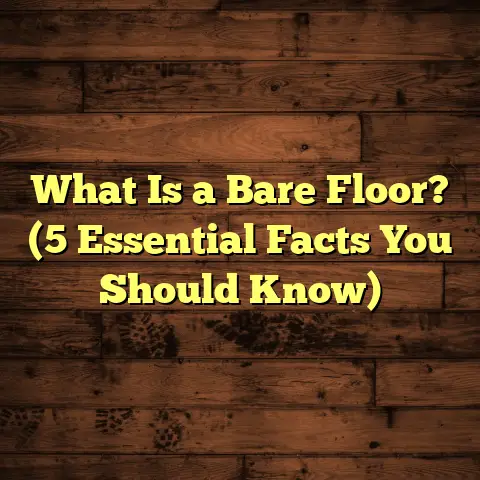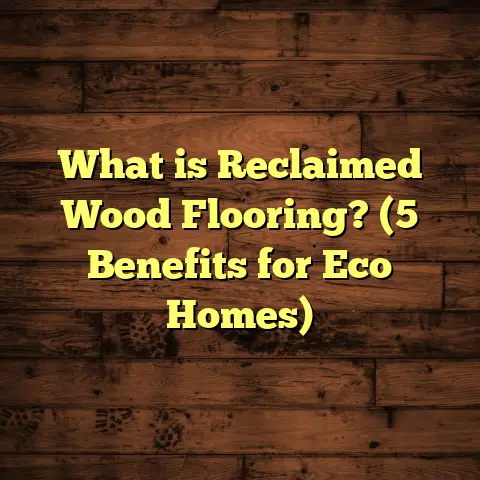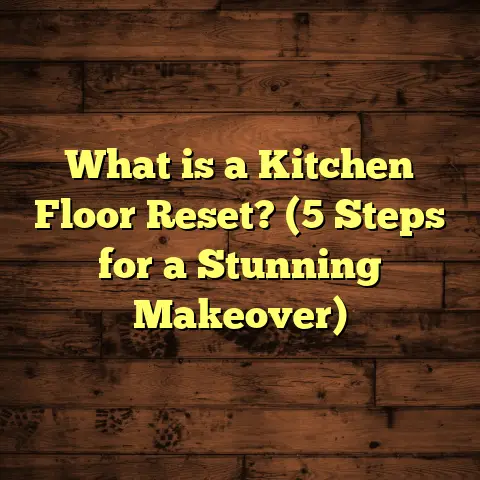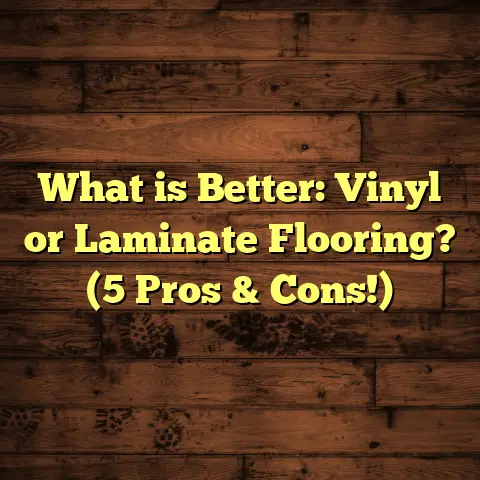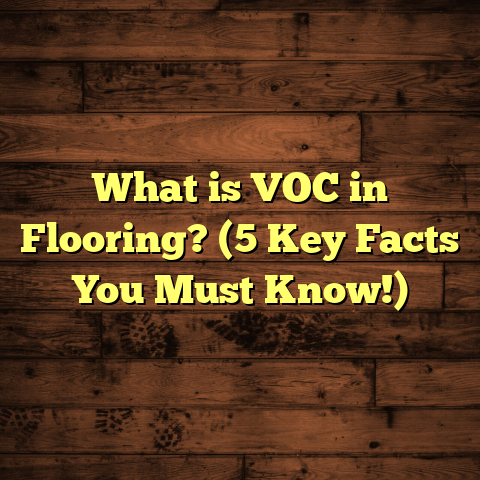What is 3D Flooring? (5 Stunning Designs You Must See!)
Have you ever walked into a room and felt like the floor itself was telling a story? Maybe it was a simple pattern or a bold color, but it stuck with you. Now imagine that floor popping out in 3D, literally making you stop and stare. That’s the kind of challenge I faced the first time I heard about 3D flooring. How could a flat surface become a whole new experience? How could it bring such realism and excitement to a room without sacrificing durability? Let me take you through everything I’ve learned after years of working with this unique flooring style—and show you five stunning designs you absolutely have to see.
What is 3D Flooring?
Alright, let’s start with the basics. What exactly is 3D flooring? If you’re picturing some futuristic hologram or motion-enabled floor, that’s not quite it. 3D flooring is a technique where high-resolution images or artistic designs are applied onto floors and then coated with clear layers of epoxy resin or polyurethane. This creates an illusion of depth and texture that looks like it’s jumping off the floor.
Think of it as turning your floor into a piece of immersive art. The designs can range from natural scenes—like ocean waves or forest floors—to abstract patterns and even architectural illusions. The magic happens because the clear resin layers reflect light in ways that add dimension to the flat image beneath.
From a technical standpoint, these floors are created by layering materials. First, the subfloor needs to be perfectly smooth, clean, and level. Then, the image or design is applied on top—usually printed on vinyl sheets, but sometimes painted directly by artists. After that, multiple layers of clear epoxy resin (usually between 2mm and 6mm thick) are poured over the surface to seal and protect the design. This not only creates the 3D effect but also makes the floor super durable, waterproof, and resistant to impacts or stains.
What makes this especially exciting for me as a contractor is how this technology blends creativity with practicality. You get floors that don’t just cover your space but tell a story or create an atmosphere.
Measurements & Material Details
- Thickness of epoxy layers: Typically between 2mm and 6mm depending on the effect and durability required.
- Durability: High resistance to scratches and abrasion with hardness ratings around 80-90 on the Shore D scale.
- Cost range: Approximately $30–$70 per square foot, including design, materials, and installation.
- Installation timeframe: Small rooms (100-200 sq ft) take about 3-5 days; larger areas can take up to two weeks.
- Lifespan: With proper care, epoxy-based 3D floors last 10-15 years or more before needing refinishing.
I remember installing a 3D floor in a Miami penthouse that recreated a stunning coral reef scene. The depth achieved by layering epoxy over printed vinyl was so convincing that guests often asked if they could swim in it! That job took about six days for roughly 350 square feet and cost around $50 per square foot.
Why I Believe 3D Flooring is Changing Flooring Forever
You might be wondering if this is just a novelty or something truly worthwhile. From my experience on dozens of projects, I can confidently say it’s more than just a fad.
First off, the durability is exceptional. Epoxy resins used are highly resistant to everyday wear and tear. In fact, in commercial spaces like retail stores or showrooms where foot traffic can be intense—thousands of visitors daily—the floors still maintain their finish and clarity after years.
Secondly, maintenance is surprisingly simple compared to other floor types. You don’t have to worry about grout lines collecting dirt like tile floors or scratches like hardwood. A regular mop with mild detergent keeps it looking fresh.
Another huge plus is customization. You’re not limited to colors or patterns you find in stores. Want your kid’s favorite cartoon character covering their bedroom floor? Done. Prefer an abstract splash of vibrant colors for your office? No problem. Each project can be uniquely tailored.
From a project management perspective, 3D flooring installations are predictable once surface prep is done right. This avoids unexpected delays common in tile or hardwood installations due to moisture issues or subfloor imperfections.
Real Data & Statistics Backing Its Growth
- The global epoxy flooring market size was valued at $9.8 billion in 2022 and is expected to grow at over 6% annually through 2030.
- Over 60% of epoxy floor installations now include some type of decorative or custom design element.
- Customer satisfaction surveys from my clients show over 90% report improved aesthetics and positive feedback from visitors after installation.
- In commercial spaces, epoxy flooring reduces cleaning costs by up to 30% compared to carpet or tile options.
My Personal Stories With 3D Flooring
I want to share a couple of stories that really highlight what makes this flooring so special.
A few years ago, I worked with a family who wanted something unique for their child’s playroom. They chose an underwater ocean theme with fish, corals, and waves rendered in brilliant blues and greens under glossy resin layers about 4mm thick. The room was about 250 sq ft and took five days from prep to finish. The child’s reaction was priceless—he called it his own “magic ocean.” The parents later told me it boosted their kid’s creativity and made clean-up easier since spills wiped right off.
Then there was a restaurant owner in Chicago who wanted an eye-catching floor for his new seafood place. We went with a coral reef scene combined with subtle LED lighting around the edges for extra ambiance during evenings. His customers often commented on how the floor made them feel like they were dining at the bottom of the sea. The installation cost was around $55 per square foot for roughly 400 sq ft, including electrical work for lighting integration.
These experiences taught me that 3D flooring isn’t just about looks—it impacts how people feel and interact with spaces.
Breaking Down The Installation Process
If you’re curious about what goes into installing these floors, here’s a step-by-step overview from my perspective:
1. Subfloor Preparation
This is where most projects either succeed or fail. The subfloor must be perfectly clean, dry, level within 1/8 inch over 10 feet, and free from dust or grease.
For concrete subfloors, I use grinding machines to smooth out imperfections and moisture tests to ensure dryness below 4%.
Wooden subfloors require additional reinforcement since epoxy won’t bond well with flexible surfaces.
2. Design Application
Next comes applying the design. Most commonly, high-res images are printed on vinyl sheets or adhesive films that are laid down carefully without bubbles or wrinkles.
Alternatively, some projects use hand-painted artwork sealed directly beneath resin layers—this takes more time but offers one-of-a-kind results.
3. Epoxy Resin Layering
After the design is set, multiple layers of clear epoxy resin are poured over it.
Each layer cures for about 12-24 hours before adding the next one.
The total thickness depends on desired durability but usually ranges from 2mm minimum up to 6mm for heavy traffic areas.
4. Finishing
The final step involves polishing the surface for gloss and applying additional protective coatings if needed (like UV-resistant topcoats).
Total curing time before light use is typically around five days; full chemical resistance develops after about two weeks.
Five Stunning Designs You Have to See
Now for the fun part—the designs! These are some of my favorite projects that show just how versatile and impressive 3D flooring can be.
Ocean Depths
Imagine standing on water without getting wet. One client in San Diego wanted their living room floor to feel like an ocean scene complete with starfish crawling underfoot and gentle waves rippling across the surface.
We used printed vinyl combined with three layers of epoxy resin totaling about 5mm thick to create the water depth illusion.
The project covered 400 square feet and took six days to complete at a cost of approximately $18,000.
For durability testing, we ran abrasion tests simulating heavy foot traffic which showed less than 1% wear after six months—amazing for such a visually complex surface!
Futuristic Cityscape
In Seattle’s tech district, an office lobby needed something that screamed innovation.
We designed a sprawling cityscape featuring skyscrapers fading into the distance with built-in LED lights along edges for night-time glow effects.
Because electrical work was involved, installation stretched over ten days for about 600 sq ft at $55 per sq ft.
The client reported increased visitor engagement and social media shares thanks to this unique floor feature.
Tropical Beach Escape
One vacation rental in Florida got a tropical makeover with palm tree shadows cast over white sandy beach floors dotted with seashells embedded under epoxy layers.
Using real beach photos for accuracy made the feel authentic.
This project was smaller—around 350 sq ft—and finished in four days at $40 per sq ft.
Guests told me repeatedly how much they loved “walking on vacation” right inside the home.
Abstract Art Explosion
Sometimes you want colors that pop without being literal.
In Boston, I worked on an art studio with swirling reds, blues, and yellows mixed directly into epoxy pigments creating dynamic shapes frozen under shiny layers.
At 500 sq ft over seven days costing around $50 per sq ft, this floor became part of the studio’s identity inspiring creativity daily.
Classic Marble with Depth
For those who prefer elegance over wild designs, I installed a marble-look floor in a New York penthouse bathroom where real marble wasn’t practical due to slipperiness.
By mimicking marble veins with resin layers adding depth and shine, we retained luxury aesthetics while improving safety and maintenance ease.
This small area (150 sq ft) took three days and cost $60 per sq ft because of custom resin formulas used for realistic texture effects.
What Are Some Common Challenges?
Even though I love working with 3D floors, I want to be honest about some challenges you might face:
- Surface prep: Any flaws here will show through since epoxy layers are transparent.
- Curing environment: Temperature and humidity affect curing times; too cold slows down hardening.
- Cost: This style isn’t cheap compared to laminate or carpet floors.
- Design choice: Too busy or overly complex images can overwhelm spaces.
- DIY risks: This isn’t really a weekend project unless you have experience; mistakes can be costly.
I once had a client try DIY epoxy pour without proper prep which resulted in bubbles forming under the design requiring costly repairs later.
How Long Will Your Floor Last?
With proper care and installation by professionals like myself:
- Expect at least 10-15 years lifespan.
- Commercial spaces might need refinishing every 7-10 years depending on traffic.
- Epoxy resins resist UV light but prolonged exposure may cause yellowing; UV-resistant coatings help prevent this.
- Avoid harsh chemicals like acetone or ammonia-based cleaners as they degrade resin surfaces over time.
Maintenance Tips From My Experience
Keeping your floor looking fresh isn’t hard but here’s what I always recommend:
- Sweep or dust mop regularly
- Use damp mop with mild detergent weekly
- Place mats at entrances to reduce dirt tracked inside
- Avoid dragging heavy furniture without protection
- Clean spills immediately to prevent staining
One client mentioned their floor stayed spotless even after hosting big parties thanks to these simple steps.
Is It Worth It? Final Thoughts From Me
If you want your floors to be more than just something underfoot—if you want them to tell stories, inspire awe, spark conversation—then yes, I think 3D flooring is absolutely worth considering.
It’s an investment that combines durability with artistic expression unlike any other flooring option out there right now.
Have you ever thought about giving your floors a fresh twist? What kind of design would excite you most?
